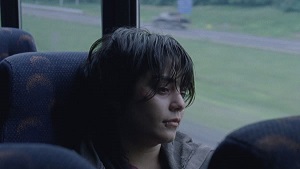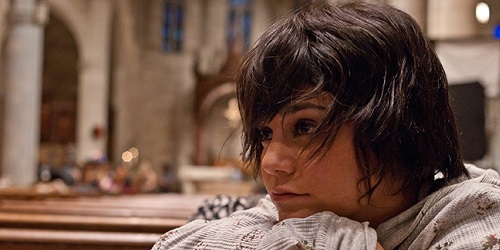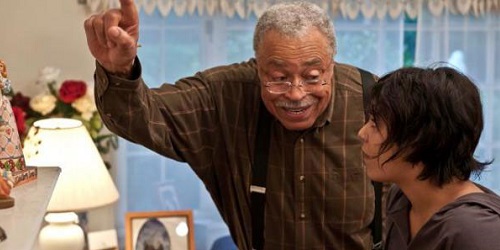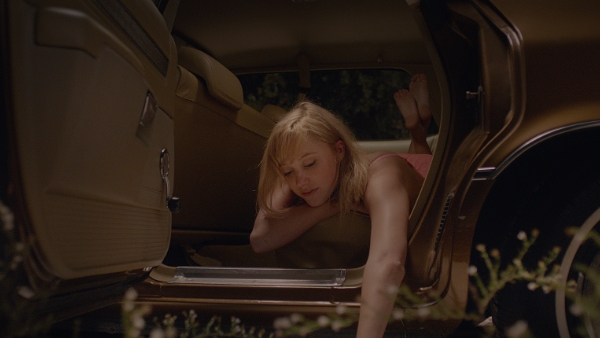 Think of Ron Krauss’ Gimme Shelter as the next phase in Vanessa Hudgen’s plan to recalibrate her career; it’s the continued tale of how she’s graduated from high school musicals and shed her Disney skin in an attempt to become a bona fide Actress. Truthfully, Hudgens doesn’t really need to tinker with her image much further following her stint in last year’s lurid Spring Breakers, Harmony Korine’s transgressive cultural commentary on disaffected youth, but she nonetheless appears to have arrived at a point in her life where she’s no longer content appearing in disposable teenage romances and terrible Twilight clones. It’s time for her to get real.
Think of Ron Krauss’ Gimme Shelter as the next phase in Vanessa Hudgen’s plan to recalibrate her career; it’s the continued tale of how she’s graduated from high school musicals and shed her Disney skin in an attempt to become a bona fide Actress. Truthfully, Hudgens doesn’t really need to tinker with her image much further following her stint in last year’s lurid Spring Breakers, Harmony Korine’s transgressive cultural commentary on disaffected youth, but she nonetheless appears to have arrived at a point in her life where she’s no longer content appearing in disposable teenage romances and terrible Twilight clones. It’s time for her to get real.
 Therein lies the hook to the film – it’s based on a true story, though how directly or loosely remains a matter of interpretation. To write Gimme Shelter‘s screenplay, Krauss reportedly resided at a home for disadvantaged pregnant teenagers for a year, taking stock of the difficulties inherent to a life lived in the shadow of abuse, destitution, isolation, and hunger; Hudgens herself spent two weeks in a similar situation as preparation for the role. Clearly, verisimilitude and reality are important factors here, and in the abstract their efforts can be appreciated, even if it’s not clear whether the narrative Gimme Shelter spins builds off of one individual or instead offers a composite of the hardships of many.
Therein lies the hook to the film – it’s based on a true story, though how directly or loosely remains a matter of interpretation. To write Gimme Shelter‘s screenplay, Krauss reportedly resided at a home for disadvantaged pregnant teenagers for a year, taking stock of the difficulties inherent to a life lived in the shadow of abuse, destitution, isolation, and hunger; Hudgens herself spent two weeks in a similar situation as preparation for the role. Clearly, verisimilitude and reality are important factors here, and in the abstract their efforts can be appreciated, even if it’s not clear whether the narrative Gimme Shelter spins builds off of one individual or instead offers a composite of the hardships of many.
The problem is that practice and execution live several blocks away from each other, and Gimme Shelter only makes it about halfway between the two. Krauss places his focus on Apple (Hudgens), sixteen years old, stuck in a decrepit brothel with her volatile mother, June (Rosario Dawson), and at the end of her rope with a bun in the oven; the film begins as she makes a break for it, determined to yank herself out of the cycle of addiction she’s been stuck for her entire existence. Her journey takes her back and forth from New Jersey to New York (though for all that Krauss cares, Gimme Shelter could be located anywhere) as she goes in search of a better life for her unborn child and for herself.
If that sounds terribly cliche, well, it is, though giving credit where it’s due, the film starts off promisingly enough despite being grounded in plot trappings that feel all too familiar. Krauss doesn’t appear to favor much in the way of subtlety or nuance; he sends Apple fleeing from the monstrous June (you can tell she’s on drugs because she looks like she’s wearing the Crypt Keeper’s dentures), promptly ejects her from the relative safety of a cab for lack of funds, and sets her on a path where she winds up in an impressively jarring car accident. In between all of that, she tracks down her rich Wall Street broker dad, Tom (Brendan Fraser), but he’s barely present as a character in the film until the end, functioning more like a pit stop on Apple’s road to salvation.

What Gimme Shelter ultimately wants to do (and takes far too long to accomplish) is maneuver Apple into the shelter of the title, run by one Kathy DiFiore (Ann Dowd), the very real founder of the Several Sources Shelters who worked with Krauss to bring his film to fruition. It’s within the confines of this particular space that Apple grows, develops as a human being, becomes part of a new family, and starts to become interesting; until that point, she’s just the sum of her parts, more often than not articulated outright to the audience through blunt, clunky exposition designed to clarify the idea that Apple’s had a hard life. If you can’t figure that out within Gimme Shelter‘s opening minutes, well, you’re probably part of the target audience that Krauss clearly doesn’t trust enough to connect the dots without serious hand-holding.
So he wastes our time by overstating the obvious. There’s actually a very streamlined film within Gimme Shelter that’s capable of expressing the exact same ideas and sentiment in a far more elegant fashion; Krauss just doesn’t know where to find it, or perhaps he doesn’t feel bothered to. Maybe he’s just a sucker for loud proclamations in which his characters leave absolutely no doubt as to what motivates them and why. Whatever the case may be, the absolutely hideous dialogue and speechifying that defines Gimme Shelter scars it irreparably, mangling a potentially interesting synthesis of the themes and backdrops found in films like Juno and Precious.

The writing here is so awful, in fact, that judging performance becomes a nearly impossible task. Is Hudgens really any good here? She mean-mugs her way through a huge portion of Gimme Shelter‘s running time, perhaps of her own accord, perhaps at the behest of Krauss, but she’s never worse than when she’s speaking to us directly about how bad Apple has it on the streets.; alternately, she shines when she’s allowed to simply act and add her personal embellishments to Apple’s persona. The film’s more veteran performers – Dowd, as well as James Earl Jones, playing a hospital chaplain with soulful authority – avail themselves well of the material here, but they know how to act around atrocious writing. Hudgens doesn’t have quite the same gift of experience, and it shows.
G-S-T Ruling:
And neither does Krauss. Whatever gifts he might have as a researcher, he’s a horrible dramatist. There will undoubtedly be reviews which take issue with Gimme Shelter‘s blatant ideological agenda – it’s art that speaks to a pro-life stance, though Krauss coyly describes his film as “pro-love” (though it’s worth pointing out that many movies claimed by the pro-life crowd tend to revolve around, you know, a choice) – but the real dilemma here is that he’s not much of a storyteller or thinker. Anyone could have cobbled this thing together. Given what he and Hudgens put into it outside of principal, that’s possibly the harshest indictment anyone can make of their efforts.




